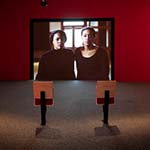The major exhibition of works by Bouchra Khalili attests to the artist’s committed enquiry into the hidden histories of solidarities among transnational and stateless communities through a selection of significant projects over the last 15 years. Neither fiction nor documentary, her work interweaves varied visual and sonic materials, formulating hypotheses for new emancipatory forms of belonging.
Spanning film, photography, print, installation, publications and textile, the Morocco-born artist’s work centres around collaborations with members of communities rendered invisible by the nation-state. Her collaborators act as ‘civic poets’ who merge the personal and collective, and, together with the artist, develop alternative ways of witnessing history. Employing montage as a tool for articulation and speculation, Khalili’s narrative style invites her audience also to become active collaborators and eventually join the cohort of civic poets populating her works.
The two key words in the exhibition’s title—circles and constellations—echo the potential communities envisaged in Khalili’s works. Circles refers to al halqa, a traditional Moroccan form of storytelling in which people across generations gather in a circle and exchange memories and political ideals. While this type of civic gathering has been present in the artist’s practice from the beginning, it is highlighted in her recent works revolving around the theatre groups founded by North African migrant workers in 1970s France as well as her new two-channel installation The Public Storyteller (2024), which was shot in Marrakesh. ‘Constellations’, on the other hand, arise in the network of transnational solidarities that the exhibition reveals by connecting different migrant and anti-colonial groups and their struggles across seas and continents.
The two-channel film installation The Public Storyteller (2024) foregrounds oral transmission as an act of resistance while linking past political strategies to the present day and future. The film concludes Khalili’s series of works initiated in 2017 around the Movement of Arab Workers, its theatre groups Al Assifa [The Tempest] and Al Halaka [The Circle], and the presidential campaign of the 18-year-old Al Assifa member who ran in the 1974 French election under the pseudonym ‘Djellali Kamal’. Fifty years after Kamal’s campaign, Khalili films this story, narrated in Marrakesh to young Moroccans in the tradition of al halqa. Through al halqa and the layout of the installation, the circle becomes a continuing metaphor for the movements of time and history and a motif highlighting the ritualistic dimensions of spectatorship.
Sea-Drifts (2024), an embroidered tapestry piece, continues Khalili’s long-term research into migration routes, building on her extensive work The Mapping Journey Project (2008–2011), which traces the convoluted journeys of eight anonymous individuals, among others, in search of a better life. This new work tracks eight specific migratory journeys linking the North and West African coasts to the Canary Islands. These irregular routes, first developed in the early 2000s, are considered among the deadliest migratory paths due to the dangers of sailing across the vast expanse of the Atlantic Ocean. Khalili isolates these arduous passages and renders them on fabric dyed with natural indigo. Referencing the colonial history of this organic compound, the artist connects these modern migration trajectories with indigo trade routes from the sixteenth century. Subverting the traditional function of map-making, which historically served as a tool to assert power, Khalili redefines it as a means to bear witness to the experiences of stateless individuals and those compelled to undertake illegal travel.
The Constellation Series (2011) is the concluding chapter in Khalili’s The Mapping Journey Project. Using silkscreen, the artist transposes each journey across the Mediterranean onto a blue backdrop, whose shade lies between the sea and the night sky. In the absence of borders and other barriers, each pathway appears like a celestial constellation. Throughout history, constellations have served as visual manifestations of folklore and mythology as well as navigation tools in spaces where landmarks did not exist. In The Constellations Series, Khalili lets these singular paths give rise to a collective narrative, offering a new perspective on our shared world.
Bringing these works together, the exhibition bears witness to what the artist calls ‘radical citizenship’, an unconditional conception of community freed from normative notions of identity.
Between Circles and Constellations is organised by Sharjah Art Foundation and MACBA Museu d’Art Contemporani de Barcelona. The exhibition is curated by Hoor Al Qasimi, Director and President of Sharjah Art Foundation, with Amal Al Ali and Meera Madhu, Curatorial Assistants at Sharjah Art Foundation.
Press release from Sharjah Art Foundation
Image: Bouchra Khalili. The Constellations Series. 2011. Installation view. Seeing through Stone, San José Museum of Art, 2024. Photography by Glen Cheriton. Courtesy of the artist and SJMA.



